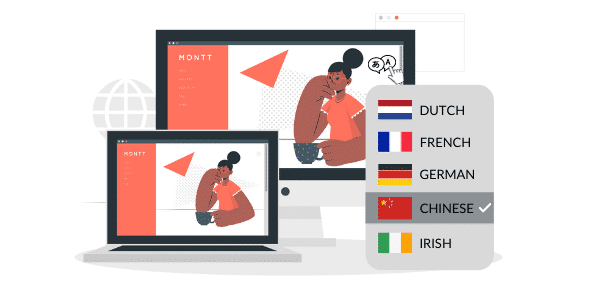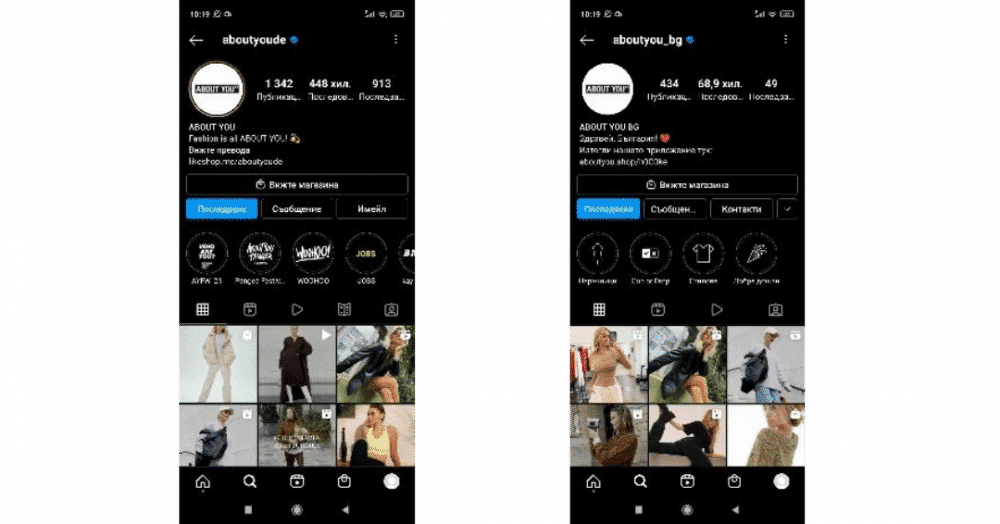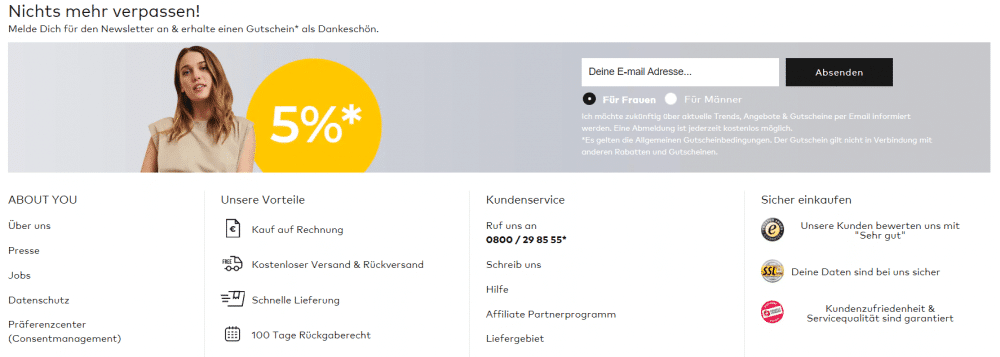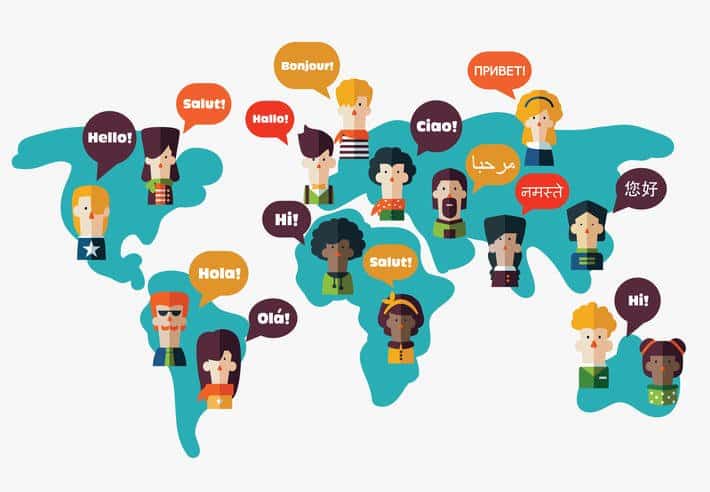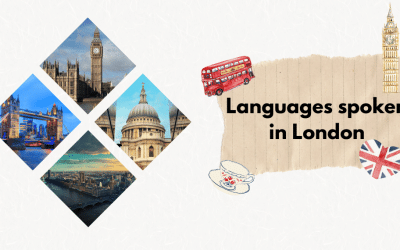“Can’t read, won’t buy” is the title of a study that examines consumers’ buying preferences regarding multilingual websites. The study found that people are way more likely to purchase from a website in their native language.
Over half of all participants claimed that they were only shopping at websites in their mother tongue. What’s more, only a quarter of all participants would buy a product if the website was in a foreign language.
Similarly, Shutterstock found that 80% of global consumers are more willing to do business with a foreign company if it grants them a personalized and localized experience. In addition, localized brands get 86% more clicks than sites available only in English.
More brands are localizing their websites to offer their customers a more personalized and relevant experience. This, in turn, could result in better conversion and sales opportunities.
Maybe you’re aware of the benefits of a localized and optimized multilingual website, but it might be the cost that stops you from taking the next step.
Website Localization can be an expensive investment- but it is worth it if you do it correctly.
It is high time to stop delaying the next move!
Website Localization Best Practices
To help you with the localization of your website, we have devised a list of the top eleven best practices for building a multilingual website that you need to have in mind!
1. Machine Translation is not the answer.
When translating your website’s content into new languages, do not rely on Machine Translation (MT). If you opt for this approach, contact a professional translator who will review the MT output and correct it accordingly.
Remember that some automated, free-of-charge translation tools (e.g., Google Translate) are general engines. This means that they are not specialized for a specific type of content (e.g., manuals, marketing materials, etc.) and their specific vocabulary. As a result, the output will likely contain many mistakes.
Some content might be translated with MT – for the Translation of comment sections, Q&As, and reviews, MT is a proper tool.
However, machine-generated translations are unsuitable for your home page, landing pages, contact, and about pages.
Moreover, MT does not consider textual and cultural contexts. This, in turn, means that they do not differentiate between subtle nuances of meaning. Thus MT can produce a translation containing words and phrases that might offend your target audience.
Amazon relies entirely on MT for the Translation of their product descriptions, comments, and reviews. It is important to note that Amazon’s engines are specifically created and trained for their needs, leading to significantly higher quality output.
However, for their main information pages, legal pages, UI, and seller central, Amazon still uses human translators and editors
Also Read Machine Translation and Post Editing: Everything You Need to Know
You need human translators to ensure quality.
To ensure quality translation and appropriate language, always turn to a professional linguist to translate your content into a new language.
What’s more, besides translating your content, your website’s content might need to be adapted to the cultural preferences of your target audience. In this case, MT is not an option at all.
Instead, make sure to employ professionals who can adapt your content to your target audience—expert know-how to localize content properly and prevent misunderstandings.
2. Translate everything
As we all know, the devil is in the smallest detail. Thus, you always have to make sure that all content on a single page is translated!
If there are different buttons, pop-up messages, menu sections, images with text, etc., you have to work on every single element on a web page you are translating.
Untranslated words or sentences are the best way to disappoint your clients, so pay close attention to the smallest detail!
When starting to work on your multilingual website, do not translate all your content into the new language. Start slowly and progress from there.
A single translated page might not seem like a lot, but if the Translation and localization are correctly done, then your customers will be more than pleased.
Having your whole website poorly translated by an automatic tool would inevitably lead to offended customers, so do not make that mistake!
Also read: 11 Elements To Consider For A Successful Localization Strategy
Localize your website to effectively reach customers around the world
Milestone helps you seamlessly translate content & localize your website, products, and services in 70+ languages. Get in touch with us for a special discount.
3. Transcreation instead of Translation
As we have mentioned in the previous point, sometimes Translation is not enough. In such cases, you have to utilize transcreation services to adapt your content to your target audience’s preferences.
Transcreation is a service that works with the following aspects:
- User target group
- Bias free language
- Tone of voice
- Style
- Meaning
- SEO keywords
- Images
What’s more, you do not need to transcreate (or translate) every page. Some pages might be irrelevant to your target audience, so you might as well leave them out.
Usually, all home pages, mission/vision pages, tag lines, testimonials etc., should be transcreated. It is best to consult a professional who can decide the best transcreation strategy for your website.
Regarding the pages you decide to adopt, it is essential to keep in mind that they still need to look identical. The content (e.g., images, text, graphs) might not be exact; nevertheless, follow the same design and overall layout as in the other language version of your website.
For example, to make your content look consistent in several languages, you can consider using ready-made templates. These templates are created with the latest design trends, and they are suitable for most websites. Additionally, you can customize the colors and images to fit the unique style of your website.
Also Read: Translation, Transcreation and Transliteration: What’s the diifference?
4. Multilingual UX – Make All Features Visible
When setting up your multilingual website, you have to ensure that all you do is with your customers in mind. This means that you have to invest all your efforts into bringing comfort to your users.
Comfort regarding websites can be accomplished through easy access. But what does it mean?
The easiest way to do so is by making all UX features visible at first sight. You can utilize brighter colors, different fonts or text sizes, pop-up messages, etc., to bring your customers’ attention to a specific feature.
Have a look at the main page of Facebook. It has a simple design in light blue color. The only elements popping up beside the logo are the log-in button in blue and the sign-up button in green.
Indeed, these are the two main elements on this page, and they are made highly conspicuous and accessible by using brighter colors – a technique you might want to implement!
Also read: Localizing Colors For Different Cultures
However, there is one element missing. You could go back to the picture above and scrutinize it.
You might have noticed that there is no language-switch option available.
While having such an option is not a must, one click on the language toggle can make your user experience much more enjoyable.
Suppose you opt for having a language-switch button. In that case, you are faced with two options: either having the flags where a language is spoken or simply listing all the available languages as on Tesla’s website.
Tesla
This is an essential aspect of accessibility since some clients might be color blind, and simply having the flag icons listed will hinder them from choosing the option they want.
What’s more, don’t make the mistake of having a language toggle only on the main page of your website. Make sure that it is available all the time, regardless of which page the user browses through.
For instance, I often switch websites to Russian since I’m trying to improve my language skills. However, when I cannot comprehend the content in Russian, I would always switch to a language I understand better.
It is best to situate the language toggle in the top right corner, but there are various approaches, as you can see from Facebook’s website below.
It would make a world of difference to have the language toggle on every page. Indeed, a multilingual website is useless if the user cannot find the toggle button for the language they can understand.
Also Read: Top Global Brands With Exceptional Localization Strategies
5. Choose your domain wisely
An effective URL strategy is one of the critical elements when it comes to a multilingual website. Always choose a URL that can be easily remembered and is directly associated with your brand.
Thus, it is best to use either your company’s name or keywords that are relevant to your brand. Still, don’t go overboard – keep your domain name as short as possible to avoid confusion.
Last but not least, do your research – you don’t want clients to mistake your domain for another one. So, always opt for domain names that are original and do not infringe any trademarks.
As for your country domain, you can choose from three main options:
- a country code top-level domain (websitename.de)
- subdomain (de-de.websitename.com)
- a subdirectory (websitename.com/de-de/)
However, you can do a combination of two or three types. For instance, the international cosmetics company NIVEA has a multilingual website available in more than 100 countries. When visiting nivea.com, you can choose from a long list of countries.
What is most remarkable about Nivea’s multilingual website strategy is that some versions implement the country code top-level domain (e.g., https://www.nivea.pl/) while others a subdomain (e.g., https://www.nivea-afrique.com/).
How do you determine which language to show a user
Please do not make a mistake automatically redirecting a user to a language based on their location. Firstly, the system that estimates the site is not always accurate, especially in regions like Europe where countries are very close.
Secondly, browsing from a specific location does not mean that the user knows the local language. For instance, if a German tourist in China is browsing your website, they will be automatically redirected to the Chinese version of the site.
You might opt to choose the language of the system the user is using. So if a German user has a German set as their system language, your website will open in German no matter where in the world they open it.
If you want to use the IP location option, you can create a pop-up message asking the user which language they prefer.
Also read: Top 6 Languages For Your Business
Localize your website to effectively reach customers around the world
Milestone helps you seamlessly translate content & localize your website, products, and services in 70+ languages. Get in touch with us for a special discount.
6. Multilingual Website Design – Create a Comparable User Experience across Languages
It is essential to make sure that your users’ experience is comparable. For this purpose, it is best to create standard modules or universal templates, which you can then utilize when building the language versions of your website. This approach can be constructive when it comes to text expansion.
As you may know, some languages take up more space than English, for instance. Designing the website’s header and footer and navigation bar, etc., with text expansion in mind, can aid you in the more straightforward adaptation of your multilingual content later.
Nevertheless, comparability does not boil down to the design and layout of your website. In fact, “a comparable user experience” should be considered in terms of maintenance.
In other words, all updates have to happen across all languages. You don’t want any of your customers to have an out-of-date experience since it can reflect poorly on your image.
For instance, if you decide to update your main page in English, you have to keep in mind that all the languages it is available should undergo this same update.
Also Read: Localization vs Globalization vs Internationalization vs Translation
7. Translate all Interactive Features
Besides your content, you have to ensure that all interactive features are available in multiple languages. This means that you have to set up multilingual contact services such as local phone numbers and email support.
Multilingual support is a must! Ensure local contact details (e.g., phone, email, Skype, Whatsapp, etc.) for each locale. You have to ensure that if your clients need help, they can reach out to your company most efficiently and effectively
In some cases, even if a client is not satisfied with a product and calls client support to return it, effective communication in their local language can be the key to winning back their trust.
Still, multilingual support would not be enough to reach new customers. You need to have multilingual communications across channels.
Creating a local experience across all communication platforms
We live in a world where social media is ubiquitous. Thus, it is advisable to set up social media accounts (e.g., Facebook, Instagram, Twitter, etc.) in multiple languages for each of your target audiences.
While this is not an easy job to set up and maintain numerous social media accounts in various languages, it brings many benefits.
Besides attracting more clients, multilingual social media accounts can also improve your SEO (more about SEO comes next).
For instance, ABOUT YOU is a German online retailer currently expanding to new markets in Europe. To reach a wider audience, they have created an Instagram profile for each new target locale:
Also Read: Things to Consider When Localizing for the German Market
They post regularly in the language of their target audience on each of their accounts. What’s more, they offer contact services in each of their locales:
8. Optimize for Multilingual SEO
Search Engine Optimization (SEO) is the name of a system of algorithms by Google. Its main aim is to rank the accessibility and value of various websites, comparing them according to specific search queries.
Multilingual SEO optimization is essential for gaining popularity and new customers. The geographic location is a critical factor in determining the possible search results. This means that when people search in Google, the results are dependable on their site.
To ensure that foreign customers will find your website easily, there are certain practices you need to incorporate.
Firstly, make sure to indicate the language in your URL domain.
Secondly, add meta tags in the web page head elements to indicate the region and the language the page is intended to use. In this way, the search engine will know that similar content is not duplicated but language variants and thus is appropriately indexed.
Note: Remember that Google is not the only search engine. Optimize your SEO for different standards so that your website reaches global visibility through other popular search engines such as Yahoo and Bing.
Also read: Multilingual SEO – Importance, Benefits & The Process
9. Take Font Compatibility into Consideration
Different languages might require different strategies to layout to optimize your website’s design. This is especially true when it comes to your choice of fonts.
Of course, using a custom font might be the unique mark of your brand. Nevertheless, keep in mind that custom fonts are not compatible with all languages. This applies in the cases of languages with non-Latin alphabet such as Russian, Arabic, Bulgarian, etc.
The World Wide Web Consortium (W3C) aims to develop Web standards, including guidelines for web design. They advise using the Google Fonts platform with universal fonts compatible with a vast range of alphabets.
10. Translate Terms and Conditions
Always translate your terms and conditions into the language of your target audience. Generally, you are not legally obliged to do so; however, it would make a world of difference to your non-English speaking customers.
The laws regarding this aspect differ from country to country. For instance, no law obliges websites to translate their terms and conditions in English or any other language in the US.
In Canada, on the other hand, the “Official Languages Act” requires all websites to have their legal agreements in English and French – the two official languages in the state.
For instance, the Canadian activewear company Lululemon has its terms and conditions translated not only in French and English (because of the Official language Act) but also in German:
The reason for that is that according to German laws, every website needs to have a German version of its terms & conditions.
This means that if Lululemon or any other company wanted to sell their products in Germany, they had to translate their legal agreements in the expected language.
Indeed, the court in Berlin, Germany, instructed WhatsApp to translate their terms and conditions. The court’s main argument was the fact that English might disadvantage users who do not understand it.
While not every country has a law that requires translating legal agreements, you should consider it carefully. Having all your legal agreements translated into the language of your target audience shows your clients that you value their comfort and accessibility.
Note: Legal agreements should never be translated with MT. These texts contain information, and the slightest mistake might lead to huge misunderstandings. Make sure that a professional translator at least reviews the output so that it is error-free.
Also read: Legal Translation: Importance, Challenges & Best Practices
11. Strive for Inclusivity and Professionalism
Although this is the last point of our list, it is as important as the ones above. Your customers should be the main driving force when setting up your multilingual website.
You have to always work with their comfort in mind. Make your website not only accessible but also inclusive. This means that you have to take their traditions, cultures, and beliefs into consideration.
Customers from the US, Spain, Russia, and China are very different. Make sure to show your respect toward their preferences.
Be careful with which companies, organizations, and values that your brand affiliates with. You might choose to stay neutral on specific political or religious issues. However, you might as well be proactive and engage in social, religious, or political affairs.
For instance, H&M is currently advertising sustainable products. It seems contradictory that a fast-fashion brand is producing sustainable clothing from recycled materials. Nevertheless, they try to be part of the ongoing trend.
Last but not least, regardless of your attitude towards public affairs, always strive for professionalism. This is the best way to attract and win new customers!
In conclusion
Setting up and maintaining a multilingual website is not an easy task! However, with the right partners by your side, this whole process can be as easy as child’s play. This is why you should always look for professionals who can help you with the Translation, localization, design, etc., of your multilingual website!
We’re here to help. We can help you localize your site in 70+ languages.
Get in touch for professional translation and localization services.
Localize your website to effectively reach customers around the world
Milestone helps you seamlessly translate content & localize your website, products, and services in 70+ languages. Get in touch with us for a special discount.

